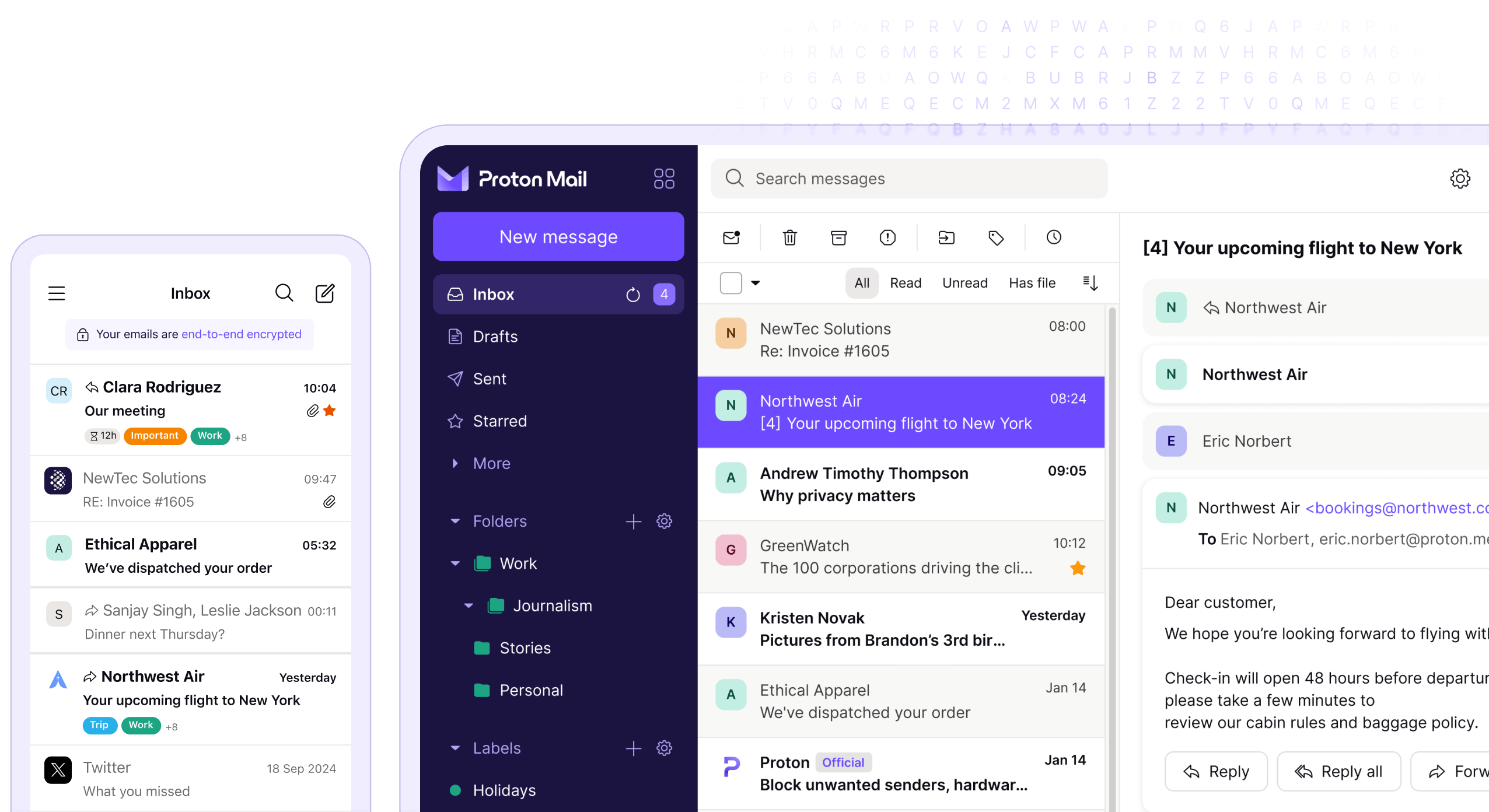Support for Proton Mail
Find answers to your questions about Proton Mail. How can we help you?

Proton Mail categories
We can help you with every step of using Proton Mail, from setting up your account to sending your first email.
Frequently asked questions
The security of our users is one of our top priorities. Here's how we make Proton Mail secure:
- End-to-end encryption: Messages between Proton Mail users are transmitted and stored on our secure servers in an encrypted format. Because your data is encrypted at all steps, the risk of message interception is largely eliminated.
- Zero access to your data: Only you have the key to decrypt your messages and files stored on our secure servers. Your data isn't accessible to anyone else — not even us. As we don't have the key to access your data, we can't hand it over to third parties.
- Password-protected Emails: Messages between Proton Mail users are end-to-end encrypted automatically. But you can also send end-to-end encrypted messages to people on other email providers using Password-protected Emails or standard PGP encryption.
- Open source: All our apps are open source and independently audited, so anyone can check our code.
- Strong physical security: We've invested heavily in owning and controlling our own server hardware. Our data centers are located at highly secure sites that require biometric access.
We created Proton Mail to make encrypted email easily accessible to everyone around the world. We know that some of the people who need our service the most will not be able to pay. That's why we offer Proton Mail Free — our free email plan that offers the same level of security and ease of use as our paid plans.
If you'd like more storage, unlimited folders, labels, and custom filters, custom email domains, and more, consider upgrading to a paid plan. You'll not only get advanced features. You'll also be supporting our drive to make online privacy and security accessible to everyone.
Encryption is a process of converting messages or information in such a way that only authorized parties can read it. Using complex algorithms, a message is transformed into an illegible string of characters. The only way to transform the message into its original format is to use a unique encryption key.
When you send an email to other Proton Mail users or when you receive a message from another Proton Mail user, the message body and the attachments are fully and automatically encrypted at every step. This is called end-to-end encryption.
All the messages and attachments you receive in your Proton Mail mailbox are also stored with zero-access encryption, including messages from other email providers. Only you have the key to access your messages and files on our secure servers. That means your data isn't accessible to anyone else — not even us.
You can also send end-to-end encrypted messages to people on other email providers using Password-protected Emails.
Otherwise, they will be protected with TLS encryption if the non-Proton Mail server supports it.
Proton has four different email domains that you can use to create email addresses:
- @proton.me is the default domain for Proton Mail. You'll be asked to create a @proton.me address (yourusername@proton.me) when you sign up.
- @protonmail.com is an alternative domain that you can choose when you sign up or use to create additional addresses (yourusername@protonmail.com).
- @pm.me is our short domain. You can activate your short email address (yourusername@pm.me) after you've signed up, if your username is available.
- @protonmail.ch is our original Proton Mail domain. If you joined Proton before 2016, you have an additional free @protonmail.ch address (yourusername@protonmail.ch).
To activate your @proton.me address, log in to your account (account.proton.me) and click Settings → Go to settings → Identity and addresses.
If you have a paid Proton plan, you can create additional addresses (aliases) using any Proton domain above or your own custom domain (@yourdomain.com).
Learn more about types of addresses and aliases
You can also set any address as your default sending address.
Proton Mail Bridge is an app for Windows, macOS, and Linux. It allows you to use your Proton Mail account with third-party email clients such as Outlook, Thunderbird, and Apple Mail while keeping your mail secure with Proton Mail’s end-to-end encryption.
Proton Mail Bridge is available for all paid subscribers. To use it, install the Proton Mail Bridge app, then configure your favorite email client for it.
If you have a paid Proton Mail plan, you can use a custom domain to send and receive emails (for example, using the email address yourname@yourdomain.com). The number of custom domains you can use depends on your Proton Mail plan.
You can purchase custom domains from third-party registrars, such as GoDaddy, Cloudflare, or Namecheap. To use a custom domain with your Proton Mail account:
- 1. Add your domain to your Proton Mail account
- 2. Verify your domain so that Proton knows it is genuinely yours
- 3. Configure your domain registrar’s DNS records so that Proton Mail handles the emails sent and received using that domain
Additional steps are required if you have a Proton for Business plan and wish to add users to your organization so that they can use your custom domain.